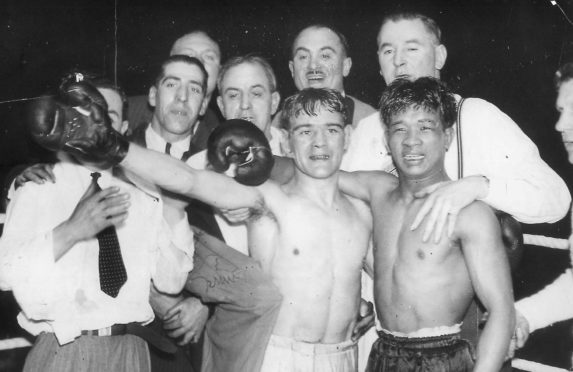
As he stood triumphantly opposite his opponent after 15 rounds of brutal action, his hand raised in victory, Benny Lynch was declared the undisputed champion of the world.
It was the culmination of an incredible journey, a true rags-to-riches tale that was breathtaking in its speed of ascent. But if the Glasgow boxer’s rise was meteoric, his downfall was as spectacularly swift and sudden.
His Wembley victory over the highly-rated American fighter Small Montana, on January 19, 1937, proved he was the true flyweight champion of the world, following a dispute about his status from across the Atlantic. There was no arguing over the identity of the true champion now.
Lynch had lifted the world, European and British flyweight titles 16 months earlier in a bout in Manchester, defeating Jackie Brown in the second round, having already knocked him down eight times in the brief contest. Thousands of fellow Glaswegians greeted him at Central Station on his return home from that defining contest in Manchester, with the crowds lining the streets all the way back to his Gorbals birthplace.
Lynch was brought up in the deprived slums there, the son of Irish immigrants. He was only 5ft 4in and slightly built, but he possessed a power to his punch that belied his frame and he soon began to train at boxing clubs and took part in fights in the fairground booths at nearby Glasgow Green.
He turned professional in 1931 and fought more than 100 bouts in just seven years, an unbelievable statistic when looked at today.
Nine months after his career-defining victory over Montana, 40,000 people turned up at Shawfield Stadium in Glasgow to watch him defend his titles against Peter Kane. Lynch also fought at Anfield in Liverpool, Celtic Park, and the Kelvin Hall.
Benny was box office, but outside of the ring he was soon to be hampered in a way no boxer inside the squared circle could ever manage.
His downfall was the bottle, with Lynch becoming a chronic alcoholic. His training suffered, as did his conditioning and body, and he was soon turning up to bouts too heavy.
He lost his world title on the scales, unable to make the weight for his scheduled bout against Jackie Jurich in June 1938. The bout went ahead without the title at stake – and Lynch won.
But the cracks had long since started to appear and alcohol, combined with money problems and a number of run-ins with the law, took its toll.
His final bout was later that year, when he suffered his only knockout loss. With boxing gone from his life, his speed of deterioration accelerated and he passed away in August 1946, aged just 33.
In scenes similar in size to those that greeted Lynch upon his return home from Manchester as the champion 10 years earlier, but much more sombre in tone, the streets of Glasgow were lined to pay tribute as the funeral cortege passed through.
Forty years after his death, he was named in the Ring Magazine Hall of Fame, and in 1998 he was inducted into the International Boxing Hall of Fame.
His boxing legacy has withstood the test of time and he is often named in lists of the greatest boxers of all time, and has influenced the Scottish world champions who have come after him, as he memorably led the way.

Enjoy the convenience of having The Sunday Post delivered as a digital ePaper straight to your smartphone, tablet or computer.
Subscribe for only £5.49 a month and enjoy all the benefits of the printed paper as a digital replica.
Subscribe